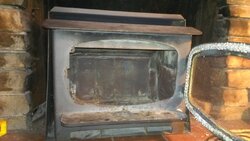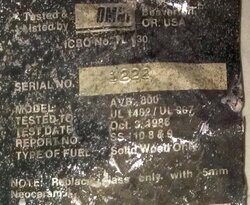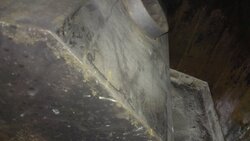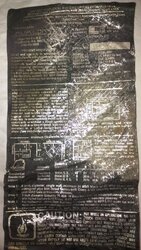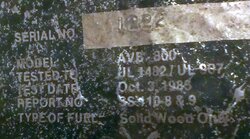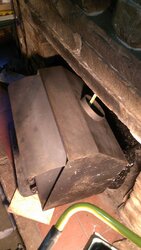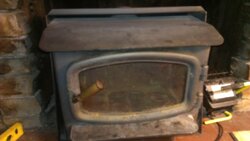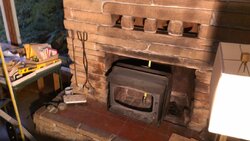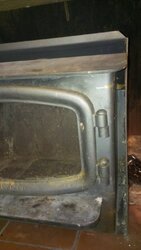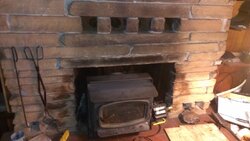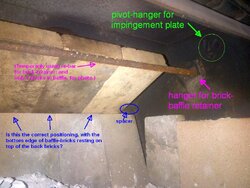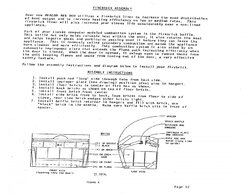Just an update, for anyone else who has or acquires an Avalon AVB-800. I was able to hand-make the internal parts very easily. I'm a newbie so I'm not offering this as advice, simply relaying what I did, and how, in case this interests others. I'll leave it to the experts to chime in with opinions and advice.

As noted above, none of the internal 'workings' of my insert came with it (except for the damper). So I had to make my own. Turns out it was *much* easier than I expected! If you are comfortable cutting and drilling 1/8" holes in a 2"x1/8" piece of metal (using a hand-held hacksaw works just fine), then you can do this. I used the drawing in the manual (attached to my prior comment) as a rough guide. (Making the damper piece would have been much more difficult, especially without specs or a model.)
There are three basic 'parts' to make: 1) the brick baffle (5 firebricks resting on a 1" angle metal retainer), 2) an "impinger plate," and 3) the push-rod (that pushes the impinger-plate closed). I'll address these in turn.
Materials needed from a hardware store:
(be sure to use iron or steel for all parts; not zinc or aluminum, which melt):
1x1 x1/8 metal "angle" bar, at least 24" long (for the brick baffle retainer)
2x2 x1/8 metal angle, at least 24" long
2 x 1/8 flat metal, at least 24" long
1/2" steel rod, at least 36" long, maybe 48"
1/8" steel rod, only need about 12" (or: you can use steel or iron nails)
3 stainless-steel lock-washers sized to closely fit over 1/2" rod. Do not use zinc.
3 stainless-steel nuts and bolts, roughly 1/2" or 3/4" long, roughly #10 size (to attach flat bar to 2x2 angle). Do not use zinc.
firebricks: enough to line the inside of stove (back, bottom, front, left, right), and 5 more bricks for brick baffle on top. (half-height bricks) Get 2-3 extra in case you break any.
Optional: get an extra hacksaw blade and maybe a new 1/8" drill bit while you are there.
Total cost: less than $30.
Tools needed:
hacksaw
drill with good bit to drill through 1/8 iron bars
hammer
bench-vice (helpful; or use vice-grips)
screwdriver and wrench to attach nuts/bolts
metal-file (optional)
First, line the stove with firebricks (back, bottom, front, left, right), leaving 5 bricks for the baffle.
1) Brick baffle: so easy.
a) Just measure and cut the 1x1x1/8 angle bar to snugly fit the retainer-hangers located on each side. (From memory I think it was 22.5", but measure to be sure.) Go ahead and put it in place.
b) You will need to cut one of the firebricks a little narrower (the long way). Fit 4 bricks in, 2 on each side, then measure and mark how much you need to cut off the middle 5th brick. You can use a hacksaw, score it at least 1/4" all the way around then tap it with a hammer. Go ahead and put the bricks in place, making sure they are seated snugly (especially in the middle). The back edge of the baffle bricks sit in front of the 'spacer', on top of the back row of firebricks.
2) Impinger plate: much easier than it seems. (Caveat: I don't know the exact factory dimensions or design, so this is a make-shift. No promises nor guarantees implied, this is just what I did.)
a) cut the 1/2" rod to fit into the impinger-hangers on each side. It should be a little loose to allow it to roll, so maybe 22.25". With a metal-file, you can round the ends a bit, to allow it to roll easily.
b) cut both the 2x2x1/8 angle and the 2x1/8 flat metal a little shorter than the rod (to clear the hangers), maybe 22"? I can't remember exactly.
c) create three 2" pins, using the 1/8" steel bar. (Or if you have 1/8" nails, then cut off the pointed end, leaving the head on and a 2" shaft.) If making your own, then grip in a vice and beat a head on one end using a hammer.
d) place the 1/2" rod in the elbow of the angle and mark where you will drill 3 holes evenly spaced, into which later you will insert pins/nails to hold the rod in place but allow it to spin freely. I.e., roughly 9/16" away from the inside angle corner. (This design allows the plate to pivot in two ways: on the hangers and cradled in the pins.) Remove the rod and drill these holes for pins.
e) Next, drill 3 more holes on the
opposite side of the angle that you drilled holes for the pins, about half-way to the edge, evenly spaced, and leaving an inch or so space away from the pins' holes (so that you can tighten bolts placed in this second set of holes). You will use these holes to bolt the flat piece to the angle piece.
f) The next step is to drill 3 holes in the flat piece, matching the second set of 3 holes in the angle. You will use these to bolt the flat piece on the 'outside' (convex) of the angle, so that gravity helps swing the impinger-plate down and forward when the door is opened.
(I don't remember the exact measurement/placement I used -- maybe about 3/4" down into the flat piece?? -- and I'm not sure of the exact original design anyway. I just guessed, based on the crude drawing in the manual. I did it so that when it is in place and the door is closed, the bottom of the impinger plate touches and overhangs the bottom of the brick-baffle retainer by about 1/4". Perhaps it should be flush?, or perhaps even fit up to the top edge of the baffle? I don't know -- I am hoping someone who has the original hardware will post pics!) In order to line up the holes properly, I suggest drilling just one hole on the flat piece at first (lining it up by placing the angle on top), then bolt the flat piece to the angle using that first hole, and then drill a second hole again using one of the angle holes as your guide, and bolt it, then drill the 3rd and 4th holes and bolt them.
g) Now see if it fits in the stove's hangers. (I left the pins "as is" at first, to make it easier to get in and out. Once I was sure of the fit, and finished with the push-rod, and that it all works, then later I bent the pins with a hammer to help keep the plate attached to the 1/2" rod.)
3) 1/2" Push-rod: again, much easier than it seems. The challenge is to cut it to the correct length -- I'm afraid I didn't take measurements, but you can cut a pencil or wooden dowel as a test model.
a) cut the 1/2" rod to length -- the goal is that when the door is closed, the push-rod is pushed up against the impinger-plate, swinging it closed. If your push-rod is too short, it will not close the impinger-plate. If it is too long, the door will not close or you will break the fire-glass if you force it (so be careful!!). I cut one too short at first, then my second one was just right. (Again, I rounded off the ends a little, using a metal-file.)
b) Once you've cut it, a simple way to keep the push-rod in place is to crimp a few lock-washers onto it. (I used a bench-vice; vice-grips would work. Squeeze just enough to bend and close the lock-washer a little bit.) The placement does not need to be exact -- maybe 1" from one end? Near enough to the impinger-plate to allow room for it to slide down when the door is open, but not so near the end that it slides way out and gets in the way when the door is open and you're loading wood. Maybe 1" or so should be sticking out by the door when opened. I used a bench-vice to squeeze the lock-washers on, one at a time. The bench-vice also lets you position them easily, by slipping the push-rod down into the vice suspended by the washers (on either side), you can then tap the push-rod lightly with a hammer to position the washers.
Put it all together inside the stove. It's a little tight, but not too bad to wiggle things around and get it in place. (I think the push-rod has to go in first, then the impinger-plate).
I've attached some photos, in thumbnails. Please let me know if it would help if I write labels on these, or take additional pics.
If anyone else has an Avalon AVB-800, we'd all welcome seeing photos of the original impingement-plate and push-rod, especially pics of where the plate meets the brick-baffle!
These internal parts are meant to play crucial roles for your stove. The brick-baffle retains heat, creates a secondary combustion of hot gases overhead, and slows down the heat from escaping up your chimney. The impinger-plate should pivot down on its 1/2" rod when you open the door: this allows fire, smoke and hot gases to escape faster up the chimney rather than bursting forward into the room and burning you. (Always open the damper wide open first, also, before you open the door on a fire, to help prevent flash.)
Nice design, for a 28 year-old stove/fireplace-insert!

I'm very pleased with the Avalon AVB-800 so far. I'm sure it is not as efficient as modern stoves that cost $1,000+, but I got mine free, and its a heckuva lot better at heating the house than just the open fireplace. It was relatively easy and inexpensive (< $30) to make by hand the replacements for its internal parts. Mine draws well (on 12 feet of a vertical 6" liner), burns well, the damper works well (to adjust the burn rate and to retain heat) and it throws out a lot of heat. Sometimes I'll point a tiny little fan at it, to help circulate hot air in the house. More often than not my boiler doesn't even kick in when the Avalon is burning.
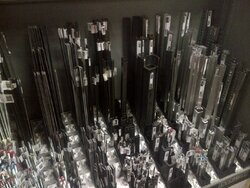
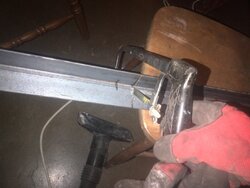
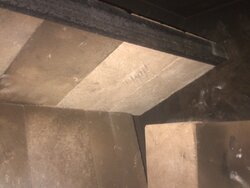
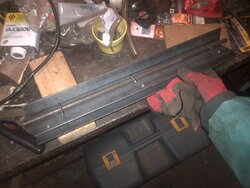
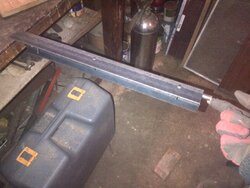
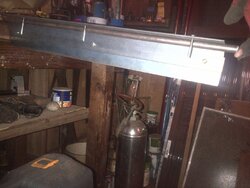
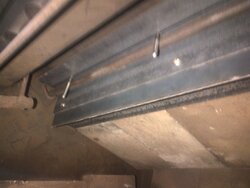
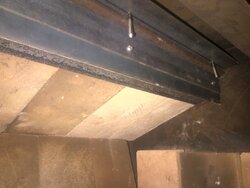
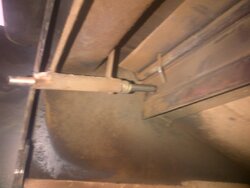
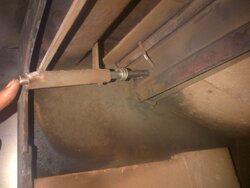
 (http://www.avalonfirestyles.com/travisdocs/93508063.pdf PDF) It is also not listed on the Avalon "discontinued manuals" page: http://www.avalonfirestyles.com/DiscontinuedManuals.aspx (This makes me worry that maybe the 800 was defective, so they've removed it??? Or maybe not enough were made, although my SN is 1222.)
(http://www.avalonfirestyles.com/travisdocs/93508063.pdf PDF) It is also not listed on the Avalon "discontinued manuals" page: http://www.avalonfirestyles.com/DiscontinuedManuals.aspx (This makes me worry that maybe the 800 was defective, so they've removed it??? Or maybe not enough were made, although my SN is 1222.)  (http://www.avalonfirestyles.com/travisdocs/93508063.pdf PDF) It is also not listed on the Avalon "discontinued manuals" page: http://www.avalonfirestyles.com/DiscontinuedManuals.aspx (This makes me worry that maybe the 800 was defective, so they've removed it??? Or maybe not enough were made, although my SN is 1222.)
(http://www.avalonfirestyles.com/travisdocs/93508063.pdf PDF) It is also not listed on the Avalon "discontinued manuals" page: http://www.avalonfirestyles.com/DiscontinuedManuals.aspx (This makes me worry that maybe the 800 was defective, so they've removed it??? Or maybe not enough were made, although my SN is 1222.) 

